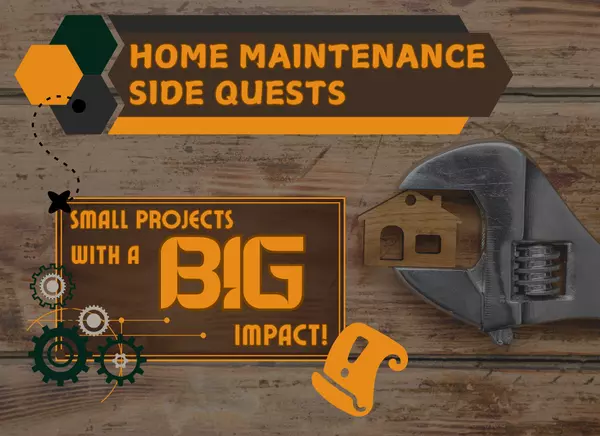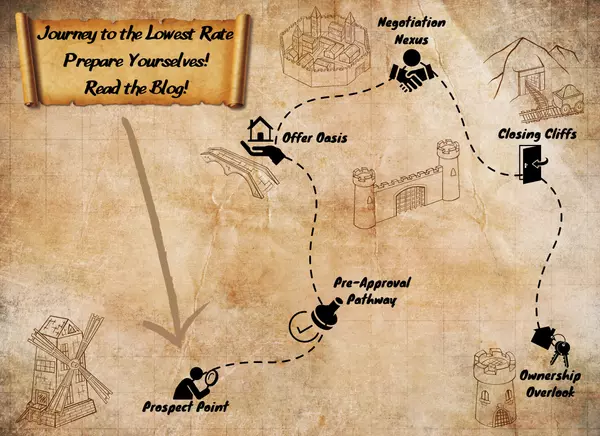Quest Accepted: A Dad's Guide to Moving with Kids
Quest Accepted: A Dad's Guide to Moving with Kids
Embark on an Epic Adventure with Your Family
Moving to a new home can feel like setting off on a grand quest, especially with little adventurers by your side. As a dad and a real estate professional, I understand that moving with kids adds excitement and challenges. But fear not! With the right strategies and a positive attitude, you can turn this journey into a rewarding family adventure.
Start the Conversation Early - Begin the Quest with Open Dialogue
Every epic journey starts with a plan. Talk to your kids about the move as soon as possible. Children thrive on routine, and a move can seem like a big plot twist in their story.
- Explain the Reasons: Share why you're moving in simple terms. Whether it's for a new job, to be closer to family, or for a fresh start, letting them know helps them understand.
- Set Expectations: Discuss what will change and what will stay the same. Reassure them that favorite toys, family traditions, and pets are coming along.
- Encourage Questions: Let them ask anything that's on their mind. Answer honestly to ease their concerns.
By involving them early, you build trust and give them time to adjust to the idea.
Involve Kids in the Planning - Equip Your Little Adventurers
Empower your children by involving them in the planning stages of the move. Giving them responsibilities and choices transforms them from passive participants into active contributors.
- Choose Their Rooms: If possible, let them select their new bedroom or decide how to arrange it. This gives them something exciting to look forward to and a sense of ownership over their new space. It can also spark their creativity and make them feel more connected to the new home.
- Create Checklists Together: Sit down and make packing lists or a moving checklist before you start packing. Turning tasks into fun missions or challenges can make the process enjoyable. For example, create a "treasure hunt" for items that need to be packed or set up a reward system for completed tasks.
- Decision-Making: Involve them in decisions like picking out new paint colors, choosing decorations, or selecting which toys to bring along. This involvement teaches valuable life skills like organization, responsibility, and decision-making. It also helps them feel more in control during a time of change.
By making them part of the process, you help ease their anxieties and foster a collaborative spirit. Involving them also strengthens family bonds and makes the moving experience more enjoyable for everyone.
Visit the New Home and Neighborhood - Scout the New Territory
Exploring the new environment beforehand can significantly reduce the fear of the unknown. If circumstances allow, take your kids to visit your new home and neighborhood before the move.
- Explore Local Parks: Visit playgrounds, parks, or recreational areas. Show them where they can play and have fun. If they see familiar activities they enjoy, they'll be more excited about the move. Bring along a picnic or plan a fun activity to create positive associations.
- Visit Schools: Arrange a tour of their new school. Meeting teachers and seeing the classrooms can help them feel more comfortable on their first day. Ask if they can meet potential classmates or join a school event.
- Meet Neighbors: Introduce yourselves to families in the area. If there are kids around the same age, setting up a playdate can help your children start building new friendships. Familiar faces on moving day can make a big difference.
- Find Points of Interest: Locate places like libraries, ice cream shops, or movie theaters. Highlighting these fun spots can turn apprehension into anticipation. Create a list of places they want to visit once you move in.
Familiarizing them with their new surroundings turns the unfamiliar into something exciting and manageable. It also gives them stories to tell and share, making the new place feel more like home even before you arrive.
Declutter Together - Lighten the Load for the Journey
Moving is an excellent opportunity to sort through belongings and decide what truly matters.
- Teach Letting Go: Explain the benefits of donating items they no longer use.
- Organize Together: Go through toys, clothes, and books to decide what to keep or give away.
- Make It Fun: Turn decluttering into a game with rewards or challenges.
By decluttering together, you reduce the moving load and help your children develop organizational skills that will benefit them throughout life. It also makes packing and unpacking more manageable.
Packing with Purpose - Prepare for the Adventure Ahead
Packing doesn't have to be a tedious task. With a bit of creativity, it can become an engaging activity that the whole family enjoys.
Make Packing Fun
- Set Challenges: Turn packing into friendly competitions. Who can pack their clothes the fastest while keeping everything neat? Who can come up with the most creative way to pack their toys? Who can go the longest without popping bubble wrap? This adds excitement to the process.
- Play Music: Create a playlist of favorite songs to keep energy levels high.
- Decorate Boxes: Let them personalize their boxes with stickers and drawings.
- Storytelling: Make up stories or adventures related to the items being packed. For example, "These toys are going on a journey to a new land." This sparks imagination and makes the task more engaging.
Label Boxes Clearly
Clear labeling is crucial for an organized move. This makes unpacking more manageable and less chaotic.
- Color-Code Rooms: Assign a specific color to each room and use colored markers or stickers on the boxes. This visual cue helps movers place boxes in the correct rooms. It's especially helpful if you have professional movers assisting.
- Detailed Labels: Write a brief description of what's inside each box. This makes finding specific items easier when unpacking. Include notes like "Open First" for essential items.
Pack a 'First Night' Box
Having essential items readily available can make the first night in your new home comfortable.
- Include Necessities: Pack pajamas, toiletries, a change of clothes, medications, and any special bedtime items like a favorite stuffed animal or blanket. This ensures everyone has what they need without searching through boxes.
- Add Comfort Items: Consider including a small surprise, like a new bedtime storybook or a small toy, to make the first night special. This can help your child feel valued and cared for during the transition.
By packing thoughtfully, you ensure a smoother transition and minimize the stress of settling into your new home. It also helps maintain routines, which is important for children's comfort.
Moving Day Strategies - Navigating the Final Battle
Moving day can be hectic, but with careful planning, you can keep things running smoothly and keep stress levels low.
Keep Kids Engaged
- Set Up an Activity Corner: Designate a safe area with activities like coloring books, puzzles, or handheld games.
- Arrange Supervision: If possible, have a friend or family member help watch them.
- Provide Snacks: Have healthy snacks and water available to keep energy levels up and prevent crankiness. Consider special treats to make the day feel positive.
- Assign Simple Tasks: Give them age-appropriate responsibilities, like handing out water bottles to movers or checking that rooms are empty. This makes them feel involved and helpful.
Maintain Routines
Sticking to familiar routines during the move-in process is essential for easing them into the new home.
- Stick to Meal Times: Try to have meals at the usual times. Even if it's a quick sandwich, maintaining the schedule helps.
- Consistent Bedtimes: Ensure that bedtime remains consistent. Set up their sleeping area early, even if it's just a mattress with familiar bedding.
Routines provide a sense of normalcy amidst the chaos.
Offer Reassurance
Emotions can run high on moving day.
- Stay Positive: Your attitude influences theirs. Express excitement about the new home. Celebrate the progress made throughout the day.
- Acknowledge Feelings: If they express sadness or fear, listen and validate their emotions. Let them know it's okay to feel that way. Offer hugs and comfort.
- Highlight the Exciting Parts: Keep them informed about what's happening next. Knowing the plan reduces uncertainty. Explain each step as the day progresses.
By addressing their emotional needs, you help them navigate the day with confidence. It also strengthens your relationship by showing that you care about their feelings.
Settling In - Unpack and Explore Your New Realm
The move doesn't end once you've arrived. Helping your children settle into the new home is crucial for a successful transition.
Unpack Kids' Rooms First
Creating a familiar space helps them feel secure.
- Let Them Lead: Allow them to arrange their room how they like.
- Prioritize Their Space: Focus on setting up their rooms before tackling other areas. Having their personal space ready provides a sanctuary amidst the chaos.
- Create a Cozy Environment: Add comforting elements like nightlights or favorite bedding. Familiar scents and textures can be very soothing.
This helps them feel at home more quickly.
Explore the New Neighborhood
Getting acquainted with the community fosters a sense of belonging.
- Family Walks: Take strolls around the neighborhood to familiarize yourselves with the area. Point out interesting sights and landmarks.
- Visit Local Spots: Go to nearby parks, libraries, or community centers. Participate in events or activities.
Building familiarity fosters a sense of belonging.
Establish New Routines
Creating new family traditions can make the new home special.
- Family Traditions: Start new ones in your new home.
- Join Activities: Encourage kids to join clubs or sports teams.
- Encourage Participation: Let your kids suggest new routines or traditions they'd like to start. This empowers them and makes them feel heard.
New routines provide structure and something to look forward to, aiding in the adjustment process. They also help differentiate the new home in a positive way.
Reflecting on the Move - Complete the Quest Together
After the move, it's important to reflect on the experience and continue supporting your children as they adjust.
Encourage Open Communication
Keep the lines of dialogue open.
- Regular Check-Ins: Ask your kids how they're feeling about the new home and listen attentively. Create a safe space for them to share.
- Share Experiences: Discuss your own feelings about the move to show that it's normal to have mixed emotions. This can encourage them to open up.
- Problem-Solve Together: If they're facing challenges, like making new friends, brainstorm solutions together. Offer guidance and support.
Celebrate Milestones
Recognizing achievements boosts morale.
- Unpacking Progress: Celebrate when rooms are fully unpacked or organized. Make it a fun event.
- Firsts: Mark occasions like the first day at the new school or first playdate with new friends. Consider small rewards or special activities.
Be Patient
Adjustment takes time.
- Acknowledge the Process: Remind your children (and yourself) that it's okay for things to feel unfamiliar. Normalize the adjustment period.
- Avoid Pressuring: Let them adjust at their own pace without rushing. Each child is different.
- Seek Support if Needed: If you notice prolonged difficulties, consider reaching out to school counselors or child psychologists. Professional guidance can be helpful.
By continuing to support and understand each other's experiences, you'll strengthen your family's resilience. This period can ultimately bring you closer together.
Bonus Tips: Managing Stress During the Move - Keep the Party's Morale High
Moving is a significant life event, and managing stress is essential for everyone involved.
- Stay Organized: Use planners, apps, or calendars to keep track of tasks and deadlines. Being organized reduces last-minute surprises.
- Delegate Tasks: Don't try to do everything yourself. Assign age-appropriate responsibilities to family members. This shares the workload and teaches responsibility.
- Take Breaks: Schedule downtime to relax and recharge. Watch a movie, play a game, or simply rest. Breaks prevent burnout.
- Practice Self-Care: Ensure everyone is eating well, staying hydrated, and getting enough sleep. Good health supports better coping mechanisms.
- Stay Flexible: Accept that not everything will go perfectly. Adaptability reduces frustration. Have backup plans where possible.
- Seek Professional Help: Consider hiring professional movers to alleviate physical and logistical burdens. This can save time and reduce stress.
Remember, a well-rested and happy team is more capable of handling challenges that arise. Keeping spirits high makes the journey more enjoyable.
Q&A
Q1: How do I help my child cope with leaving friends?
A: Arrange farewells and help them exchange contact information. Encourage them to stay in touch through calls or letters.
Q2: What's the best time to move during the school year?
A: Summer is ideal, but if not possible, coordinate with both schools for a smooth transition.
Q3: How can I make the new home feel familiar?
A: Set up their room with familiar items and maintain routines.
Q4: Should I involve my kids in choosing the new home?
A: If appropriate, involving them can make them feel included and excited.
Q5: How do I handle my child's negative feelings about moving?
A: Listen empathetically, acknowledge their feelings, and focus on the positives.
Q6: What if my child doesn't adjust quickly to the new environment?
A: Be patient and supportive. If concerns persist, consider seeking professional advice.
Conclusion
Moving with kids can be a challenging quest filled with unexpected twists and turns. However, with the right approach and a positive attitude, it becomes an opportunity for growth, bonding, and new beginnings. By involving your children in the process, maintaining open communication, and embracing the adventure as a family, you'll turn the move into a memorable and rewarding experience.
Remember, every great story involves overcoming obstacles and emerging stronger. As you settle into your new home, you'll create new chapters filled with laughter, love, and cherished memories.
As a dedicated real estate professional and fellow dad, I'm here to help you navigate every step of the journey. Together, we'll transform this challenge into a triumphant adventure. Quest accepted!
Stay Connected and Join the Adventure!
Ready to embark on your own moving quest? I'm here to guide you every step of the way. With my experience as a real estate professional and a fellow parent, I understand the unique challenges of moving with a family.
Sign up on my website to stay updated on Texas real estate and get more tips for your journey. Let's conquer this quest together!
Additional Resources:
- American Academy of Child & Adolescent Psychiatry - Moving: Helping Children Cope
- Psychology Today - Moving to a New Town: The Impact on Kids
- VeryWellMind - Moving and Depression in Children
- PBS Kids for Parents - How to Talk to Kids About a Big Move
Note: This blog is intended for informational purposes and should not be considered professional advice. Always consult with experts for specific guidance.
Categories
Recent Posts















